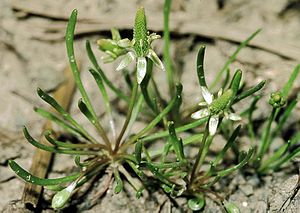Small mouse tail
| Small mouse tail | ||||||||||||
|---|---|---|---|---|---|---|---|---|---|---|---|---|

Little mouse tail ( Myosurus minimus ) |
||||||||||||
| Systematics | ||||||||||||
|
||||||||||||
| Scientific name | ||||||||||||
| Myosurus minimus | ||||||||||||
| L. |
The little mouse tail ( Myosurus minimus ), also known as the (little) mouse tail or dwarf mouse tail , is a species of plant within the buttercup family (Ranunculaceae). It is widespread in the northern hemisphere .
description
Vegetative characteristics
The little mouse tail grows as an annual herbaceous plant and reaches heights of about 5 to 12 centimeters. All parts of the plant are completely bare. All leaves stand together in basal rosettes. The grass-like leaf blades are up to 6 inches long and barely more than 2 millimeters wide, narrowly linear and with a blunt tip and smooth leaf edge.
Generative characteristics
One or more upright flower stems are formed per specimen, which are longer than the leaves and which end in a single terminal flower. The hermaphroditic flowers are radial symmetry . The bare flower base or flower axis is cylindrically shaped and after the anthesis grows to about six times the size of the fruit axis, which is up to 6 centimeters long. The five light green sepals are 3 to 4 millimeters long and oval. At the base they have a spur about 2 millimeters long, attached to the flower stalk. The five yellowish-green honey leaves are about as long as the sepals and thread-like with a tongue-shaped widened tip. There are five to ten yellow stamens . The more than 50 carpels are arranged in a spiral.
The solitary fruits are about 1 millimeter long and only 0.06 mg heavy nuts.
The number of chromosomes is 2n = 16.
Ecology and phenology
The lesser mouse tail grows as a therophyte in herds . The leaves are usually formed from March.
The flowering time is mainly in May and June. From an ecological point of view, these are homogeneous "nectar-bearing disc flowers". Pollinators are tiny two-winged birds , beetles and parasitic wasps . Spontaneous self-pollination is also possible if the stigmas brush past the anthers while the flower axis is stretching.
It is a wind spreader ; in addition, the fruits are subject to the spread of gravity, the spread of adhesion with soil and the spread as rainworms . Recently, the fruits have also been spread variously by grazing cattle. The seeds are long-lived. Fruit ripening is from May to October.
Occurrence and endangerment
Myosurus minimus occurs from Scandinavia to southern Europe and North Africa. It can also be found in the Middle East and eastern North America. It is a Eurasian-sub-Mediterranean floral element . In Central Europe it is only widespread in certain areas.
In Austria the lesser mouse tail is rare and in some areas endangered, while it may have become extinct in Switzerland. The lesser mouse tail can be found scattered to fairly widespread in northern and eastern Germany. To the west and south it becomes increasingly rare and is completely absent in many places.
The little mouse tail is concentrated on pioneer and dwarf rush communities on moist to alternately wet (periodically flooded), moderately nutrient-rich and alkaline , sometimes muddy sandy and loamy soils . Such locations can be found, for example, on pastures at step and watering points, on fields and in lanes of unpaved dirt roads, occasionally also on the banks of water. In Central Europe, together with Ranunculus sardous, it is a character species of Myosuro-Ranunculetum sardoi from the Agropyro-Rumicion association.
Taxonomy
Myosurus minimus was first published in 1753 by Carl von Linné in Species Plantarum .
photos
literature
- Henning Haeupler, Thomas Muer: picture atlas of the fern and flowering plants of Germany . Ed .: Federal Agency for Nature Conservation (= The fern and flowering plants of Germany . Volume 2 ). Eugen Ulmer, Stuttgart (Hohenheim) 2000, ISBN 3-8001-3364-4 , pp. 63 .
- Wolfgang Adler, Karl Oswald, Raimund Fischer: Excursion flora of Austria . Ed .: Manfred A. Fischer. Eugen Ulmer, Stuttgart / Vienna 1994, ISBN 3-8001-3461-6 , p. 285 .
- Christian Heitz: School and excursion flora for Switzerland. Taking into account the border areas. Identification book for wild growing vascular plants . Founded by August Binz. 18th completely revised and expanded edition. Schwabe & Co., Basel 1986, ISBN 3-7965-0832-4 .
- Erich Oberdorfer : Plant-sociological excursion flora . With the collaboration of Theo Müller. 6th, revised and expanded edition. Eugen Ulmer, Stuttgart (Hohenheim) 1990, ISBN 3-8001-3454-3 .
- Konrad von Weihe (ed.): Illustrated flora. Germany and neighboring areas. Vascular cryptogams and flowering plants . Founded by August Garcke. 23rd edition. Paul Parey, Berlin / Hamburg 1972, ISBN 3-489-68034-0 , p. 585 .
Individual evidence
- ↑ a b c d e Ruprecht Düll , Herfried Kutzelnigg : Pocket dictionary of plants in Germany and neighboring countries. The most common Central European species in portrait . 7th, corrected and enlarged edition. Quelle & Meyer, Wiebelsheim 2011, ISBN 978-3-494-01424-1 .
- ↑ a b Erich Oberdorfer : Plant-sociological excursion flora for Germany and neighboring areas . 8th edition. Verlag Eugen Ulmer, Stuttgart 2001, ISBN 3-8001-3131-5 . Page 418.
- ↑ Little mouse tail. In: FloraWeb.de.
- ↑ Carl von Linné: Species Plantarum. Volume 1, Lars Salvius, Stockholm 1753, p. 284, digitized
Web links
- Small mouse tail. In: FloraWeb.de.
- Small mouse tail . In: BiolFlor, the database of biological-ecological characteristics of the flora of Germany.
- Profile and distribution map for Bavaria . In: Botanical Information Hub of Bavaria .
- Myosurus minimus L. In: Info Flora , the national data and information center for Swiss flora .
- Distribution in the northern hemisphere from: Eric Hultén, Magnus Fries: Atlas of North European vascular plants. 1986, ISBN 3-87429-263-0 at Den virtuella floran. (swed.)
- Thomas Meyer: Data sheet with identification key and photos at Flora-de: Flora von Deutschland (old name of the website: Flowers in Swabia )



